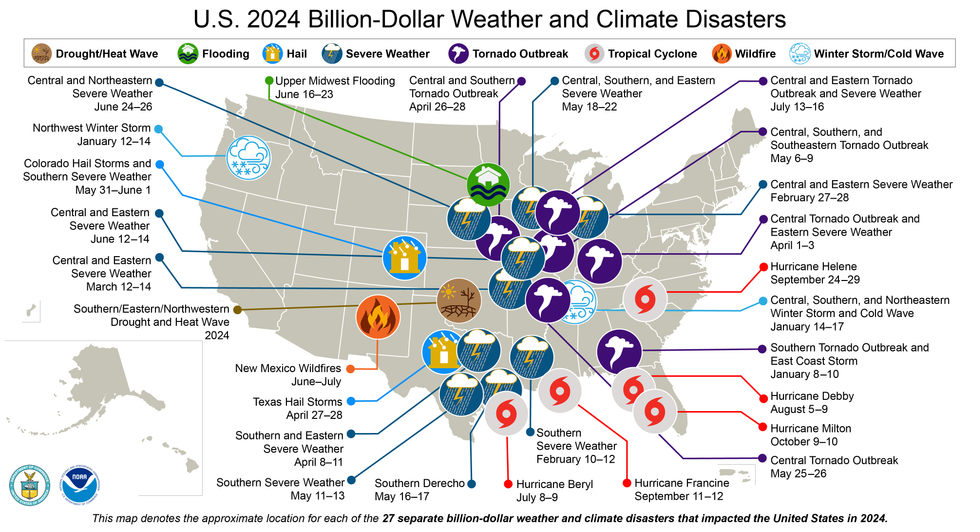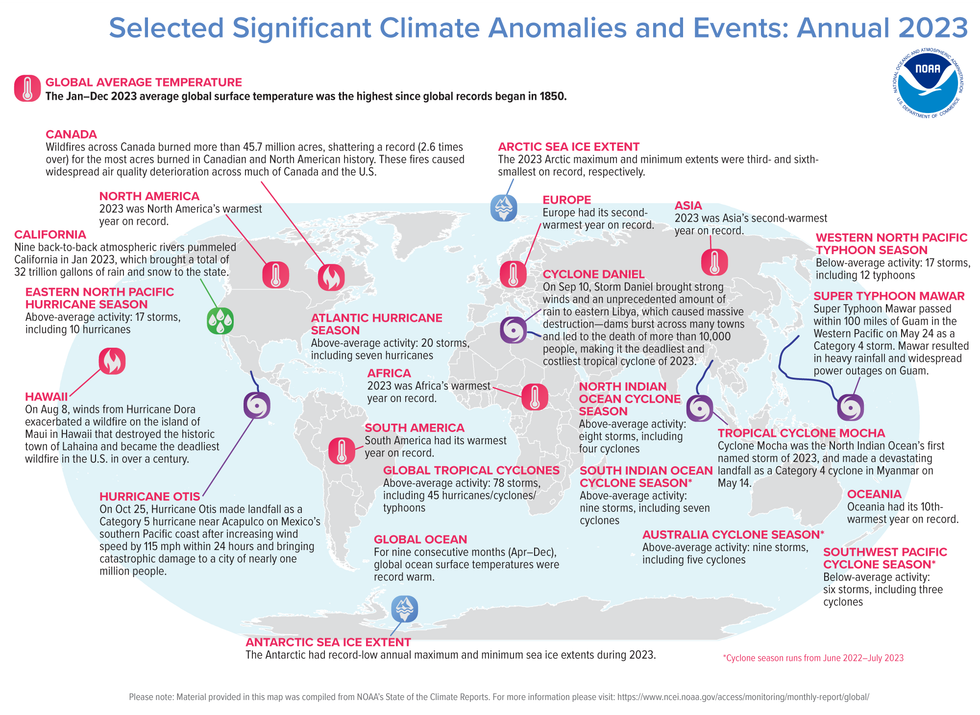"NASA and NOAA's global temperature report confirms what billions of people around the world experienced last year; we are facing a climate crisis," declared Bill Nelson, NASA's administrator. "From extreme heat, to wildfires, to rising sea levels, we can see our Earth is changing."
"It's driven primarily by our fossil fuel emissions, and we're seeing the impacts in heatwaves, intense rainfall, and coastal flooding."
NASA, whose records date back to 1880, found that Earth's average surface temperature last year was about 1.2°C above the average for the agency's baseline period, which is 1951-1980, and 1.4°C above the late 19th-century average.
"Every month from June through December 2023 came in as the hottest month on record. July ranked as the hottest month ever recorded," NASA noted in an article explaining last year's record heat, which addresses greenhouse gases, the El Niño Southern Oscillation (ENSO), warming oceans, decreasing aerosols, and an undersea volcanic eruption.
"The exceptional warming that we're experiencing is not something we've seen before in human history," emphasized Gavin Schmidt, director of NASA's Goddard Institute for Space Studies. "It's driven primarily by our fossil fuel emissions, and we're seeing the impacts in heatwaves, intense rainfall, and coastal flooding."
NOAA, which has a climate record back to 1850, similarly found that the average land and ocean surface temperature last year was 1.18°C above the 20th century and 1.35°C above the preindustrial average, or 1850-1900. Sarah Kapnick, the agency's chief scientist, said that "after seeing the 2023 climate analysis, I have to pause and say that the findings are astounding."
"Not only was 2023 the warmest year in NOAA's 174-year climate record—it was the warmest by far," she highlighted. "A warming planet means we need to be prepared for the impacts of climate change that are happening here and now, like extreme weather events that become both more frequent and severe."

Both agencies found that the 10 hottest years in their records have all been in the past decade. NOAA pointed out that there is a one-in-three chance that this year will be even warmer than 2023, and a 99% chance that 2024 will be among the five hottest years.
"We will continue to see records broken and extreme events grow until emissions go to zero," Kapnick warned. "Government policy can address both emissions, but also actions to reduce climate impacts by building resilience."
NASA and NOAA's findings are in line with not only scientists' predictions amid extreme conditions last year but also data released Tuesday by the European Union's Copernicus Climate Change Service and Friday by the United Kingdom's Met Office—which has records back to 1850 and found that the global average temperature for 2023 was 1.46°C above the preindustrial baseline.
"It is striking that the temperature record for 2023 has broken the previous record set in 2016 by so much because the main effect of the current El Niño will come in 2024," said Adam Scaife, a principal fellow at the U.K. agency. "Consistent with this, the Met Office's 2024 temperature forecast shows this year has strong potential to be another record-breaking year."
El Niño and La Niña are the warm and cool phases of the climate phenomenon ENSO in the Pacific Ocean. As Common Dreams reported Thursday, a study published in Advances in Atmospheric Sciences found that 2023 was the hottest year on record for the world's oceans, which capture an estimated 91% of excess heat from greenhouse gases.
Government scientists were not the only ones who responded with alarm to the new climate data this week. Kristina Dahl, a principal climate scientist at the Union of Concerned Scientists, said Friday, "The latest data confirms heartbreaking and unprecedented scientific truths: The last decade has been the hottest in human history while heat-trapping emissions are continuing to rise."
"During this consequential decade, nations across the globe must swiftly reduce their heat-trapping emissions and enact widespread climate adaptation policies to limit the devastating climate harms and the toll they take on humans and ecosystems," she stressed, noting the "unrelenting onslaught of climate impacts" communities have already ensured. "Continuing to make only incremental policy changes will further jeopardize the safety of people around the world, especially those on the frontlines of the climate crisis."
Dahl argued that "as the largest historical emitter of global carbon emissions and the wealthiest nation, the United States has a moral imperative to lead on aggressive climate action. The science is clear: Transformative and comprehensive climate action, including a rapid transition away from fossil fuels and investments in resilience, are essential to ensure a livable future for generations to come."
"It's time for U.S. policymakers to place the needs of people over ill-gotten corporate profits by resisting and rejecting the potent allure of greenwashing narratives and false solutions that the fossil fuel industry has long pushed upon elected officials."
"Fortunately, the United States already has proven technologies to do this, including energy efficiency, renewable energy, and energy storage, at its fingertips," she added. "It's time for U.S. policymakers to place the needs of people over ill-gotten corporate profits by resisting and rejecting the potent allure of greenwashing narratives and false solutions that the fossil fuel industry has long pushed upon elected officials."
While making historic progress on climate during his first term, U.S. President Joe Biden has also faced criticism from scientists and campaigners for backing some false solutions, enabling more fossil fuel projects, and skipping COP28, the United Nations climate summit held late last year.
Global scientists called COP28—which was led by an oil CEO in the United Arab Emirates—a "tragedy for the planet" because its final agreement did not endorse a phaseout of fossil fuels, and have already expressed concerns about COP29, given host country Azerbaijan's recent announcement that the upcoming conference will also be overseen by an oil executive.


 (Image: NOAA)
(Image: NOAA)




